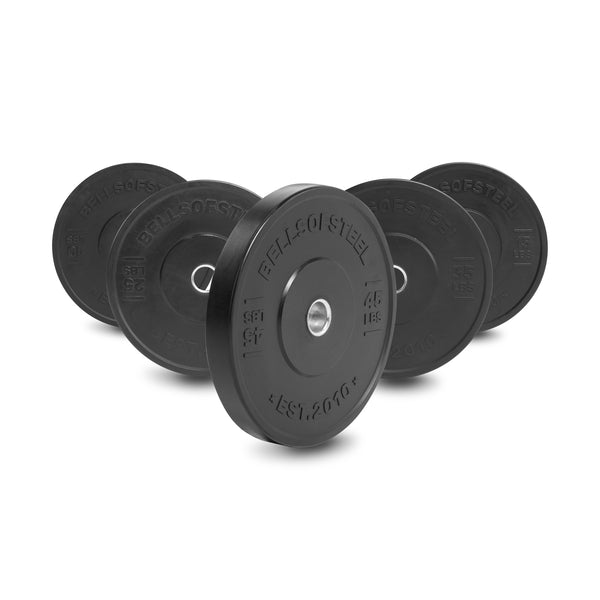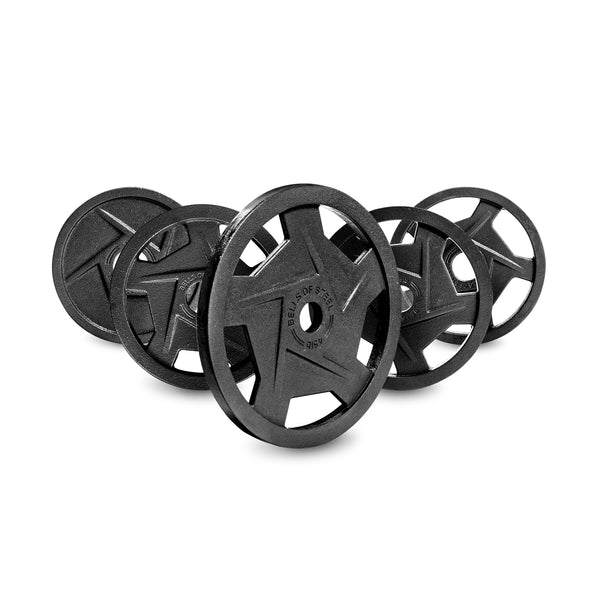When you’re starting out or planning your dream home gym setup, choosing the right weight plates can be daunting. The type of weight plate depends on a few things like the materials they’re made of, what kind of sport or exercises you’ll use them for, and of course, let’s not forget your budget!
Weight plates are an essential tool for weightlifting and can be used alone or in conjunction with a barbell. There are various plates to think about, and with each advantage and disadvantage, it's ideal to know their differences to decide which is best for you.
This article will comprehensively compare the different types of weight plates, their benefits, and how these plates affect your training. Bumper plates are a type of weight plate that is intended for use with Olympic lifts. The primary feature of bumper plates is they are encased in a rubber layer, which allows the plates to be dropped without damaging the floor or barbell. It absorbs the impact when the barbell hits the ground.
If you're training at home, even if you're just doing deadlifts, every drop will make a noise and having bumper plates will reduce the impact and the sound.
Another thing to consider is the aesthetics of the bumper plates. Most athletes like their look, and they are a consistent size and diameter - no matter the weight! The urethane and the competition bumper plates share a lot of similarities. The critical difference between these two is that urethane bumper plates are odourless and smooth to the touch.
Urethane is an ultra-durable type of rubber that makes for solid, dense-weight plates that resist bouncing and skipping. It combines the best qualities of both plastic and rubber, and it can endure a lot of pressure, making it an excellent material for bumper plates.
Urethane Bumper Plates are also extremely tough and do not scratch or scrape easily. Check out this article to learn what Urethane Bumper Plates are. The main advantage of the Competition Bumper plates is that the weights are equivalent to what is used in the IWF Olympic weightlifting competition. They are accurate to 0.1% and closely align with IWF specifications, making them ideal weightlifting training plates.
The Urethane and Competition Bumper plates are very dense and have very low bounce-back rates, which can prevent any risks or injuries from dropping your weight after a lift. Colored rubber bumper plates are visually appealing, and their eye-catching colors make it easy to identify the plates you need for your workout.
This type of weight plate is made with rubber and has a mild odor to it. However, it is incredibly durable because the hubs are made of thick stainless steel insert rings with a three-anchor point system, and the rubber build is much thicker than an ordinary coating.
These two types of bumper plates share quite a few similarities; for one, both versions are all black. The bounce on these plates is something you won’t often see in an economy-priced weight plate. These plates are one of the cleanest-looking bumper plates out there, with a smooth black finish.
The key difference between the two is that the Dead Bounce Conflict Bumper plates have colored letters to make them more aesthetically pleasing and easy identification, while the All Black Bumper Plates are pure black. They're functionally the same and ideal for recreational and competitive lifters who don’t want to break the bank. These are Bells of Steel commercial-grade low-odor bumper plates, which is ideal for high-intensity workouts where you’ll likely be dropping the bar. The crumb material absorbs more shock than traditional bumpers and is quieter and ultra-durable.
The Crumb Bumper plates can also be used on various surfaces, including grass and asphalt, and are suitable for indoor and outdoor applications. The color-coordinated flecks are a feature designed to help in weight identification.
Iron Plates are excellent for powerlifting, bodybuilding, and general fitness training. Iron plates can be great if you intend to do benching, squatting, shoulder presses, and other similar exercises. They should work fine for anything else you want to do as long as you don't plan on dropping weights on the floor.
Iron and steel plates are used interchangeably in the world of weight training. So, when you hear someone referring to iron plates, cast iron plates, or steel weight plates, they're both talking about the same thing.
Iron plates are most often the least expensive plates available. These are the traditional weight plates, which have a thinner and shorter profile. You can fit more plates on your barbell, especially if you use a bar with shorter sleeves.
Storing is also convenient with iron plates as for each decrease in weight, their size also shrinks down. The Mighty Grip Olympic Weight Plates are your standard run-of-the-mill iron. They come in different sizes per weight and feature a beautiful, ergonomic design.
These plates are manufactured in a factory with more than 40 years of experience using quality cast iron and a tight +/-3% weight tolerance / 51mm hole since they are only cast and not machined.
Another cool feature you’ll notice with the Mighty Grip Plate is its handles!
The precision grip handles make loading plates onto the bar and re-racking plates conveniently. The comfort grip also enables the plates to be used for a variety of exercises. The core difference between the Machined Iron Plates and the Mighty Grip plates is primarily the tolerance.
While still not accurate enough to be considered "precise," these machined plates tend to be far more accurate than the Mighty Grip Plates. It has a weight tolerance of +/- 1% for 45, 35, and 25 and +/- 3% for 10, 5, 2.5, and a precision fit 50.5mm center hole. They stay on very well and don't shift around a lot.
The front, edges, and back are milled to achieve that tolerance. Any excess dirt/dust is flame thrown off before being finished with an ultra-durable hammer-tone powder coat for superior toughness and chip resistance. E-coating produces the most resilient finish for any iron weight plate and lasts significantly longer. Our E-Coat Mighty Grip Iron Plates have a thin electro-coating (e-coat) that provides excellent rust resistance.
It has the same guaranteed tolerance of +/- 1% for 25-45lbs and +/- 3% for 2.5-10lbs as our Machined Iron plates. The hole diameter is precision-drilled with a tolerance of 50.5mm +.4mm, ensuring that your plates fit perfectly.
These e-coat iron weight plates' all-black design will modernize your space and serve as the stylish centrepiece of your home gym.Calibrated plates are typically used by those lifting significant amounts of weight in a competition setting. They are colored differently depending on the weight, extremely thin (just over 1 inch), and actually larger than standard plates.
Our Calibrated Powerlifting Plates, by design, provide a greater weight accuracy compared to Olympic Plates. These plates have not yet been certified by the IPF but are made to IPF specifications for calibrated weight, dimensions, and colors. As a result, they are less expensive while being just as precise and accurate as the certified version.
If you want to know more about Calibrated Powerlifting Plates, we have an article for you to check here.
We also have a blog post where we outlined a comparison between Bumper Plates vs Iron Plates. There you have it!This is a complete rundown and overview of some of the weight plates available at Bells of Steel. These aren’t the full spectrum of everything, but we hope we’ve provided a good representation of the available options for your weightlifting needs.
Now that you know everything a gym owner should know about weight plates, you can make a more informed decision based on your needs and budget.



